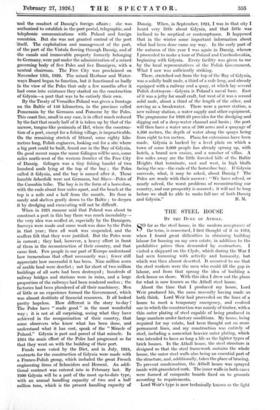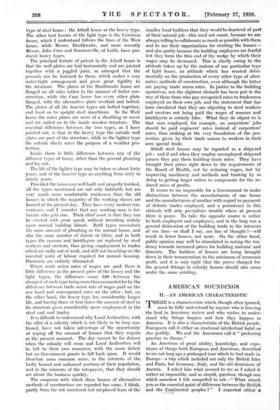S O far as the steel house, in the modern acceptance
of the term, is concerned, I first thought of it in 1919, when I found great difficulties in obtaining building labour for housing on my own estate, in addition to the prohibitive prices then demanded by contractors. I visited a shipyard on the Clyde, which during the War I had seen humming with activity and humanity, but which was then almost deserted. It occurred to me that the steel workers were the men who could fill the gap in labour, and from that sprang the idea of building a deck house on shore. With this idea I drew out the plans for what is now known as the Atholl steel house.
About the time that I produced my house, Lord Weir produced his, the same necessity having made us both think. Lord Weir had proceeded on the lines of a house to meet a temporary emergency, and evolved one in which the construction was mainly of timber, with a thin outer plating of steel capable of being produced in large numbers under factory conditions. My house, being required for my estate, had been thought out on more permanent lines, and my construction was entirely of steel, including a somewhat heavier outer plating, which was intended to have as long a life as the lighter types of brick houses. In the Atholl house, the steel structure is designed so that the steel framework sustains the whole house, the outer steel walls also being an essential part of the structure, and, additionally, takes the place of bracing. To prevent condensation, the Atholl house was sprayed inside with granulated cork. The inner walls in both cases, were formed of composite boards fixed on to grounds according to requirements.
'Lord Weir's type is now technically known as the light type of steel house : the Atholl house as the heavy type. The other best known of the light type is the CowiesOn house, which I understand follows the lines of the Weir house, while Messrs. Braithwaite, and more recently Messrs. John Cran and Sommerville, of Leith, have pro- duced heavy types.
The principal feature of patent in the Atholl house is that the wall plates are laid horizontally and are jointed together with a joggled joint, so arranged that the . grounds can be fastened to them, which makes a very water-tight arrangement and gives great rigidity to the structure. The plates of the Braithwaite house are flanged on all sides rather in the manner of boiler con- struction, while the Cran house has every other plate flanged, with the alternative plate overlaid and bolted. The plates of all the heavier types are bolted together, and fixed on to upright steel stanchions. In the Weir house the outer plates are more of a sheathing or cover and are nailed on to the inside wooden structure. The essential difference between the two types, as I have pointed out, is that in the heavy type the outside wall plates are part of the structure, while in the lighter type the outside sheets serve the purpose of a weather pro- tection.
Inside there is little difference between any of the different types of house, other than the general planning and lay out.
The life of the lighter type may be taken as about forty years, and of the heavier type as anything from sixty to ninety years.
Provided the houses are well built and properly finished, all the types mentioned are not only habitable but are very much more comfortable residences than the old houses in which the majority of the working classes are housed at the present day. They have every modern con- venience, and I consider that any working man is for- tunate who gets one. Their chief asset is that they can be erected with great speed, without trenching unduly upon normal building labour. Both types necessitate the same amount of plumbing as the normal house, and also the same number of slaters or tilers, and in both types the masons and bricklayers are replaced by steel' workers and erectors, thus giving employment to trades which are sadly out of work, and still not trenching on the essential units of labour required for normal housing. Plasterers are entirely eliminated.
Where trade union rates of wages are paid there is little difference in the present price of the heavy and the light types, the difference—some £20 betweenthe cheapest of each type being more than accounted for by the difference between trade union rate of wages paid on the one hand and unrecognized rates on the other ; but, on the other hand, the heavy type has considerably longer: life, and having three or four times the amount of steel in its structure gives considerably more employment in the steel and coal trades.
It is difficult to understand why Local Authorities, with the offer of a subsidy which is not likely to be long con- tinued, have not taken advantage of the opportunity of wiping off the amount of houses that they require at the present moment. The day cannot be far distant when the subsidy will cease and Local Authorities will be left to their own resources, with the same deficit but no Government grants to fall back upon. It would therefore seem common sense, in the interests of the badly housed and unhouscd portions of their population, and in the interests of the ratepayers, that they should set about the business quickly. The suspicion with which these houses of alternative methods of construction are regarded has come, I.think, partly from the not unnatural but misplaced fears of the smaller local builders that they would be deprived of part of their natural job—this need not count, because we are always willing to collaborate as much as possible with them and to use their organizations for erecting the houses-- and also partly because the building employees are fearful lest they form the thin end of the wedge by which their wages may be decreased. This is chiefly owing to the attitude taken up by the makers of one particular type of light house, an attitude which has reacted detri- mentally on the production of every other type of alter native methods of construction, even although the latter are paying trade union rates. In justice to the building ' operatives, not the slightest obstacle has been put in the way of those firms who pay recognized rates to tradesmen employed on their own job, and the statement that has been circulated that they are objecting to steel workers and erectors not being paid the wages of masons and bricklayers is entirely false. What they do object to is that men employed, for example, on carpenters' jobs should be paid engineers' rates instead of carpenters' rates, thus striking at the very foundation of the pro- tection given by their trade unions_ to workers in their own special trade.
Atholl steel houses may be regarded as a shipyard job ; and if and when they employ unemployed shipyard, joiners they pay them building trade rates. They have brought their prices right down to the requirements of the Board of Health, not by reducing wages, but by improving machinery and methods and trusting by so doing to getting larger orders to compensate for the re- duced rates of profits.
It seems to me impossible for a Government to make distinctions between the manufacturers of one house. and the manufacturers of another with regard to payment of definite trades employed, and a persistence in this attitude will only precipitate trouble where at present . there is peace. To take the opposite course is unfair to both employers and employees, and in the long run a general dislocation of the building trade in the interests of one firm—or shall I say, one line of thought ?—will result in fewer houses, not more. On the other hand, public opinion may well be stimulated in noting the ten- dency towards increased prices for building material and fitments. The builders of houses are being brought down in their remuneration to the minimum of economic profit, and it is only right that the prices charged for the general fittings in subsidy houses should also come under the same scrutiny.























































 Previous page
Previous page